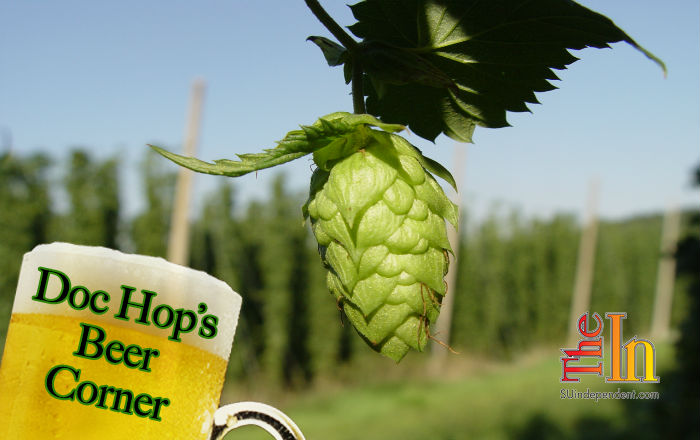 Written by Jeremy Hopkin
Written by Jeremy Hopkin“I would kill everyone in this room for a drop of sweet beer.” — Homer Simpson
It seems like perfect timing to be writing about hops. Whether due to global warming or not, I have to admit I’m loving this early spring weather in February. The air smells better. You smell a hint of vegetation in the air. You can almost hear the slow movement of the buds in the trees. An early morning walk in the desert will reward you with the faint hints of sage and cool scents of moisture in the red sand. There is no better time to drink a beer than after a nice hike with all those spring smells in your nose and summer on your mind. A nice bright aromatic hoppy beer works perfect!
Our tasting for this week will be a hop centric beer, so its time to explore this plant in some further detail. The hops flower or cone is what is used in beer, with the leaves and stem just the support system to provide us the sticky pungent cone that has all the goodness we want to get into our beer. Hops is actually the only other plant in the family Cannabaceae besides cannabis, which also grows resin rich cones for reproduction.
Hops grows vertically as a bine (not a typo – read on) to heights of 20-25 feet producing prolific medium sized leafs and sturdy stems. It is a bine rather than a vine, growing vertically by a forming concentric helical growth pattern around an existing tree or post whereas vines get vertical by attaching to surfaces with tendrils or suckers. Although hops will spread on the ground, this typically restricts its growth and it much prefers a vertical growth path. It is a perennial, dying back in the winter after producing cones in the early fall. Most plants these days are female propagations or clones. Wild hops (that still contain seeds in the cone) are pretty rare and more difficult to use in brewing.
Hops is generally considered one of the four main ingredients in beer, and is now essentially a beer defining taste. This wasn’t always the case. Hops has been around forever and people have been making grain based alcohol for close to 5-10 thousand years. Putting them together seems like such a great idea, but the best historical evidence we have indicates that the brilliant idea of combining them took a very long time. It is not entirely clear when hops became added to beer or for what reason, but it is clear that monks were intimately involved. Having foresworn the ever so pleasant but time consuming process of finding a mate and procreating, they were left with plenty of time to move beyond these banal activities and sublimate their souls to God and their minds to writing, tinkering and drinking large amounts of beer. And then writing about making and drinking beer!
The use of herbs to help flavor or preserve beer was not a new idea. Other plants such as rosemary, bog myrtle, ivy and sage had been used in beer. Hops had been used prior to beer mostly in making dyes and the occasional herbal remedy. I can just imagine the pot bellied monk, bored stiff with the duty of boiling hops to make dye – spicing up his afternoon with a warm, sticky, sweet beer. He sits there alternately wafting the resiny piney fumes of the boiling hops and swilling his barley beer wishing that it wasn’t quite so cloyingly sweet – and then he has his eureka moment! He pulls a small sample of his hop water and adds it to his brew and presto – the stars align and his beer is balanced. Not too sweet, not too bitter, but just right.
This moment of course is just a figment of my beer imagination, but it likely occurred somewhat along those lines sometime between 800-1100 AD. It is also equally possible that some cost conscious monk who looks like Gargomoyle (from the smurfs) added hops to the beer to increase its shelf life, save some money on beer and help the rich cardinal increase the monasteries bottom line – but that makes for much less pleasant day dreams. That penny-pinching bastard!
While it’s not completely clear why people started using hops, it is clear that its addition made for a superior product. Hops quickly and resoundingly beat out all other plants as the go-to preservative, bittering agent and flavoring agent in beer. And thank God, because it tastes sooo good when done right and it does substantially increase shelf life of home brews – even without refrigeration. In fact, the now ubiquitous heavily hopped IPA (India Pale Ale) was initially brewed for British troops stationed in India. The added hops was the only way they could ship the beer to India without it spoiling. Indians, in fact, were (and still are) some of the lowest volume per capita beer drinkers in the world, but the British soldiers were close to mutiny without their brewskis!
I have much more to say about hops, and I clearly couldn’t be concise enough to get it into one column. Next time around I will get more in depth about the chemical properties of hops and how it’s used in the brewing process.
In the meantime – grab Wasatch Brewery Ghost Rider pale ale. I love this beer for a couple of reasons. The first is to watch the surprised reaction of someone who says they don’t like hoppy beers drink it. Through my many years and countless beers trying to convert those blasphemous oenophiles and perverted cocktail drinkers to the light of craft beer there is one thing I have learned. When people say they don’t like beer, they usually mean that they don’t like hopped beers. Which usually means that they don’t appreciate bitterness (and they almost always have a massive sweet tooth). As an aside, I think there is a very strong correlation between those who prefer salty and savory snacks to sweets and those that gravitate towards beer. And visa versa.
Anyway, I like this beer because it highlights the aromatic and flavor contribution of hops while downplaying the bitterness that can come from hops. It has a very hop forward floral and citrus smell with little of the bitter back-bite of a typical IPA. The addition of coriander nicely rounds out the hops with a bit of a spicy aftertaste. I’ve given it to many a person who say they would just as soon drink cough syrup than an IPA and have received surprised expressions of appreciation in return. Try it out on your non beer/hop loving friend.
The second reason I love this beer is that they intentionally let the malt get out of the way of the hops. Many times when I drink an IPA the hop flavor quickly gets drowned out quickly in a background of overly sweet and thick malt base. This beer is unapologetic in letting it’s aroma hop profile dominate and take the palate for a ride. It’s also an easy drinker, so don’t be surprised if that six pack disappears before your eyes!
Cheers!
Doc Hop
 Jeremy Hopkin grew up in the heart of happy valley (Orem, UT). He received his undergraduate degree in zoology, got his M.D. degree from University of Utah, and did his residency in radiology at Dartmouth including a fellowship in neuroradiology. He is currently employed locally as a diagnostic radiologist and also treats varicose vein disease at Red Sands Vein and Laser Institute. He gives training and nutritional advice to athletes of all ages, shapes and sizes at Crossfit St. George and loves to help people attain their health goals. He is fascinated with science and is a tinkerer in all things fermentation. He’s been a home brewer for 7 years and is a beer lover for life! For questions or comments, Jeremy can be reached at [email protected]
Jeremy Hopkin grew up in the heart of happy valley (Orem, UT). He received his undergraduate degree in zoology, got his M.D. degree from University of Utah, and did his residency in radiology at Dartmouth including a fellowship in neuroradiology. He is currently employed locally as a diagnostic radiologist and also treats varicose vein disease at Red Sands Vein and Laser Institute. He gives training and nutritional advice to athletes of all ages, shapes and sizes at Crossfit St. George and loves to help people attain their health goals. He is fascinated with science and is a tinkerer in all things fermentation. He’s been a home brewer for 7 years and is a beer lover for life! For questions or comments, Jeremy can be reached at [email protected]



